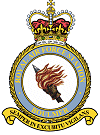 RAF
Boulmer
RAF
Boulmer
"What did you do in the "Cold War" Dad?"
Part 3 - "Linesman"
|
"He strengthened their defences
and put commanders in them with supplies of food" |
After two and a half years at Bawdsey I was posted back to RAF Locking for a six months RX12874 Passive Detection course in 1974, during which I married Sandra. I was then posted to RAF Boulmer where I served for another five years working on the Linesman Passive Detection equipment. I have described this remarkable system elsewhere on this site. I left the RAF in 1979 and we moved to Scotland - but that's another story. I went back to RAF Boulmer in 1995 for a look around; all the Linesman radars have gone now, the scars on the ground where these behemoths once stood are the only reminders that this was where we fought the "Cold War".
Following the demise of "Rotor" the air defence of the UK was reorganized once again. "Rotor" gave way to a system of "Master Radar Stations" (MRS) that provided radar coverage of the UKADR, the United Kingdom Air Defence Region. In the mid 60's MRS's started to give way to the "Linesman/Mediator" system that was served by radar's from RAF Saxa Vord in the north of the Scottish Shetland islands, RAF Buchan, near Peterhead, Scotland, RAF Boulmer in Northumberland, England, RAF Staxton Wold in Yorkshire, England and RAF Neatishead in Norfolk, England. I believe that there were also other elements, Bishops Court in Northern Ireland for example, but I have no direct knowledge of these stations or their role. The Linesman/Mediator radar stations were equipped to feed the radar data to a central control station called "L1", at RAF West Drayton, near London. I went there for a visit once, the place was huge and I had never seen so many racks of equipment in one place before. However, this centralization was shown to leave the system vulnerable to attack (exposed to the world by Rex Malik in the "Observer" of 13 October 1968) so each station was capable of operating independently. This implementation was known as SLEWC (Stand by Early Warning Control system). When we were left to function independently things worked fine. Once "L1" got involved things usually went wrong - and you can guess who got the blame. The problem was that "L1", despite its central role, was remote from the action and appeared to lack both local knowledge and understanding of our systems. Incidentally, RAF Staxton Wold, mentioned above, was one of the original "Chain Home" radar stations in 1937. The others have since closed, so Staxton Wold has the distinction of being the oldest operational air defence radar station in the world.
The principal radar equipments at RAF Boulmer were the Type 84 and Type 85 search radars, Passive Detection and the HF200 height finders. I have made up separate pages describing the Linesman system radars, you will find links to these in the left hand panel under R.A.F. Radar. I'm afraid the quality of some of my photographs is poor, the result of a cheap camera and aging film stock I regret to say. All this equipment was classified "Secret" during the "Cold War", however all of my own photographs were taken at a station open day for the public on 16 September 1978. I believe it all to be factually correct but 20+ years is a long time and the memory fades. Additionally, as all of this equipment was "Secret" in my day questions about operations and equipment were discouraged unless you needed to know the answers! To the best of my knowledge this is the only site on the entire net that can tell you a bit about the "Linesman/Mediator" system that was developed using Type 84, Type 85 and HF200 radar's as well as the unique RX12874 Passive Detection anti jamming system. If I have missed something out or got something wrong please let me know and I will correct the account (with due acknowledgement, if you wish of course).
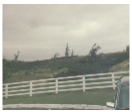 Fighter control functions were conducted from the underground "R3" bunker known as "The Hole", located to the right of the left hand picture just out of frame, that had formed a part of the "Rotor" air defence system (see the R.A.F. Bawdsey page for a description of an R3). When they built the underground R3 complex at RAF Boulmer some of the material they covered it with came, I believe, from this gully, known locally as "The Bundu" (pronounced Boon'doo). The area was thick with trees, gorse and bramble and was boggy as well. You could guarantee that at some point in a Tac-Eval exercise some bod would think it a good idea to send us "erks" in there looking for intruders. During one Tac-Eval I was in a patrol that was sent in to the Bundu to flush out an intruder. I tripped on something and went flat on my face and the barrel of my SLR dug into the ground, filling it with dirt. It took ages to clean out the muck and restore the rifle to its former condition. The two radars in the centre of the left hand picture of the Bundu are HF200's.
Fighter control functions were conducted from the underground "R3" bunker known as "The Hole", located to the right of the left hand picture just out of frame, that had formed a part of the "Rotor" air defence system (see the R.A.F. Bawdsey page for a description of an R3). When they built the underground R3 complex at RAF Boulmer some of the material they covered it with came, I believe, from this gully, known locally as "The Bundu" (pronounced Boon'doo). The area was thick with trees, gorse and bramble and was boggy as well. You could guarantee that at some point in a Tac-Eval exercise some bod would think it a good idea to send us "erks" in there looking for intruders. During one Tac-Eval I was in a patrol that was sent in to the Bundu to flush out an intruder. I tripped on something and went flat on my face and the barrel of my SLR dug into the ground, filling it with dirt. It took ages to clean out the muck and restore the rifle to its former condition. The two radars in the centre of the left hand picture of the Bundu are HF200's.
 The entrance to the R3 bunker was through a guard room like the one at Anstruther shown here. I've lost count of the number of times I've heard or seen it described as "Looking just like an ordinary farm house"! To me it doesn't and I'm sure the Russians weren't fooled; several acres of rotating and nodding antennae and an RF spectrum powerful enough to cook your lunch must have been a dead give away.
The entrance to the R3 bunker was through a guard room like the one at Anstruther shown here. I've lost count of the number of times I've heard or seen it described as "Looking just like an ordinary farm house"! To me it doesn't and I'm sure the Russians weren't fooled; several acres of rotating and nodding antennae and an RF spectrum powerful enough to cook your lunch must have been a dead give away.
|
Left: An evening view across the radar or "tech" site at RAF Boulmer. From left to right there is a Marconi S-259 transportable radar and equipment tent, the RX12874 head and the redundant Type 80 modulator building with all of the metalwork removed. |
|
|
|
Right: The 7.62mm SLR (Self Loading Rifle) If you really want to know its history and how it worked you can find a link in the Radar and Cold War links section. |
In my days at RAF Boulmer (1974-1979) the redundant Type 80 modulator building was used as the Guard HQ when we went to war. We would be issued with SLR rifles and ordered to guard the various installation however we weren't issued with any ammunition - apparently technicians were considered extremely dangerous when armed so we didn't even get blanks! This inevitably led to crowds of "erks" running around the site chasing the intruders and yelling "Bang" at the top of their voices. The intruders in turn got to throw pyrotechnics, fire blanks and make rude hand signals at us as they ran away. Revenge can be sweet though; if we caught them they were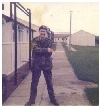 stripped to their underwear, blindfolded, the laces removed from their boots (so they flopped around on their feet - it stopped them running away) and they were marched across the tech site to the Type 80 building for "interrogation" ("'Ere's a cuppa tea mate, you wanna bicky?"). The conversion of the Type 80 modulator building was done "on the cheap" and during one exercise a brick partition wall fell over, trapping some officers in an office. The resulting hullabaloo had the tears rolling down my cheeks! Once a year we had a "Tac-eval" or Tactical Evaluation and we simulated war time conditions for three or four days. If you were on duty when the balloon went up you usually stayed at your post, all nice and warm. If you were off duty at the time you went on to guard duties, got tired, dirty, cold, wet and got to run around a lot shouting "Bang"! No prizes for guessing where I wanted to be! It was no use crying into your beer though, as some wag would always come out with the old chestnut, "If you can't take a joke you shouldn't have joined!"
stripped to their underwear, blindfolded, the laces removed from their boots (so they flopped around on their feet - it stopped them running away) and they were marched across the tech site to the Type 80 building for "interrogation" ("'Ere's a cuppa tea mate, you wanna bicky?"). The conversion of the Type 80 modulator building was done "on the cheap" and during one exercise a brick partition wall fell over, trapping some officers in an office. The resulting hullabaloo had the tears rolling down my cheeks! Once a year we had a "Tac-eval" or Tactical Evaluation and we simulated war time conditions for three or four days. If you were on duty when the balloon went up you usually stayed at your post, all nice and warm. If you were off duty at the time you went on to guard duties, got tired, dirty, cold, wet and got to run around a lot shouting "Bang"! No prizes for guessing where I wanted to be! It was no use crying into your beer though, as some wag would always come out with the old chestnut, "If you can't take a joke you shouldn't have joined!"
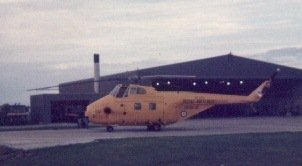 When R.A.F. Acklington closed "A" Flight of 202 Sqd. moved to R.A.F. Boulmer. The squadron functions in the search and rescue role and countless numbers of aircrew, mariners, hill walkers and mountaineers owe their lives to the bravery and tenacity of these crews who regularly carry out rescues in the most atrocious conditions. The squadron operated Westland Whirlwind helicopters for many years, eventually they were replaced by the Sea King in September 1978. The photograph on the right shows the first Sea King to arrive at Boulmer,
When R.A.F. Acklington closed "A" Flight of 202 Sqd. moved to R.A.F. Boulmer. The squadron functions in the search and rescue role and countless numbers of aircrew, mariners, hill walkers and mountaineers owe their lives to the bravery and tenacity of these crews who regularly carry out rescues in the most atrocious conditions. The squadron operated Westland Whirlwind helicopters for many years, eventually they were replaced by the Sea King in September 1978. The photograph on the right shows the first Sea King to arrive at Boulmer, 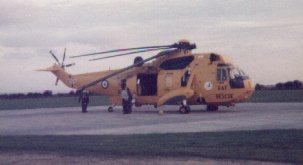 taken on the day of its arrival. If you asked them nicely the squadron would kit you out in flying gear and an immersion suit and drop you off in the sea or on a mountain somewhere. Then they'd potter off whilst you made yourself uncomfortable and come back later to rescue you. It was good
taken on the day of its arrival. If you asked them nicely the squadron would kit you out in flying gear and an immersion suit and drop you off in the sea or on a mountain somewhere. Then they'd potter off whilst you made yourself uncomfortable and come back later to rescue you. It was good  fun and made a change to working out of the sun in the R12 (the Type 85 radar building) or underground in the R3 - I did it a few times myself. If you look carefully at the picture of the Sea King you might just make out a white disc just aft of the "RAF Rescue" legend. The disc has a picture of a Mallard duck on it and was the 202 Sqd. mascot. There used to be a small duck pond by the hanger and Melanie, my eldest daughter, loved going down there "to feed the ducks" when she was a toddler. The R.A.F. has a page dedicated to 202 Squadron at http://www.raf.mod.uk/history/h202.html#202sqn
fun and made a change to working out of the sun in the R12 (the Type 85 radar building) or underground in the R3 - I did it a few times myself. If you look carefully at the picture of the Sea King you might just make out a white disc just aft of the "RAF Rescue" legend. The disc has a picture of a Mallard duck on it and was the 202 Sqd. mascot. There used to be a small duck pond by the hanger and Melanie, my eldest daughter, loved going down there "to feed the ducks" when she was a toddler. The R.A.F. has a page dedicated to 202 Squadron at http://www.raf.mod.uk/history/h202.html#202sqn
Ironically, the "Cold War" presented me with opportunities that I might not otherwise have had. The need for skilled personnel to maintain the equipment meant that I got the kind of training and experience that money can't buy, certainly no civilian training could come anywhere near it. I trained as a radar technician and later as a computer technician. I was taught mathematical logic and electronic logic techniques, I learned to programme and operate computers. I worked on the RX12874 Passive Detection system at R.A.F Boulmer from 1974 to 1979. The system was unique and to my knowledge nothing like it existed before or since. The combinations of radar, communications and computer techniques that I learned in those far off days has served me well in my subsequent career. The down side of all this expensive training is that your government might go to war one day and then it's pay back time. As I said before, "If you can't take a joke........"!
Another irony was that, despite the hype about the sports, travel and educational opportunities, the R.A.F. at that time was not always a bed of roses. A few examples may serve to illustrate the down side of serving your country.
The R.A.F. often publicized the educational opportunities available, so when the kids came along I got ideas about trying to "improve" myself, of going for a commission even and I went to see the education section to sign up for some courses. The education section was rather limited and many of the courses were taken externally; anyway under their guidance I signed up for Ordinary Level Maths and Physics at the technical college in Ashington and, as the bus system in rural Northumberland left much to be desired, I bought a small motorcycle to give me transport to and from the college. That was the easy part. Getting time off for day release study was another matter and right from the start I found I was missing more sessions than I was attending. It wasn't long before I was so far behind that I had no hope of ever catching up and so ended my attempts to "improve" myself. In retrospect it is hard to see why I couldn't be spared for one day a week; during the day there were shift workers available in addition to the day workers and it wasn't as though there were not enough of us to cover the work. Indeed, we were over manned some extent, with more corporals, sergeants and chief technicians than there were posts in which to employ them.
The rapid changes in the nature of the threat and the changing technologies dictated that the Ground Radar trade group required rationalisation. In a great consultation exercise we were informed that the trade group would be split into two groups, Air Defence and Airfields and we had to make our choice. It didn't take a genius to work out that there were more Airfield postings than there were for Air Defence (there were only around half a dozen or so AD postings at that time). Also airfields tended to have better facilities, nicer quarters, a more varied social life and so on. So naturally we all selected Airfields. Of course, most airfields and air defence units already had all the men they needed, so all the people at air defence radar stations were put into the Air Defence group and all the people at airfields were put into the Airfield group. Then we were told that something like 80% of the techs who expressed a preference got what they asked for! I never met one, though I might have if I had visited an airfield.
The "Irishman's Pay Rise" of 1976 was a shining example of government ineptitude. The pay review body recommendations were ignored, as usual, and we received a pittance of an increase that came no where near keeping up with inflation, never mind what our equivalents in "Civy Street" were earning. And then they put up the food and accommodation charges. The result was that we were worse off than before the pay rise!
All of which serves to show yet again that, "If you can't take a joke you shouldn't have joined!"
By the end of 1977 I was stationed in the middle of nowhere with a career going in the same direction, earning around £2,500 per annum and beginning to realise that the joke was going sour. I went home on leave to Scotland with my family for the New Year and whilst there a nice American man, Mr. Donovan of Dresser-Atlas, offered me £10,000 per annum, an "Aberdeen living allowance" and travelling expenses to work for him on oil rigs in the North Sea. Three weeks later I took a Gen App (General Application) form out of the draw and I wrote to my commanding officer, "Sir, I have the honour to request that I be permitted to purchase my discharge".
Off course it didn't workout that way; by the time I got out of the R.A.F. in October 1979 the North Sea job market had changed and it would be another five years before I set foot on an oil rig. But, as I said earlier, that's another story.





